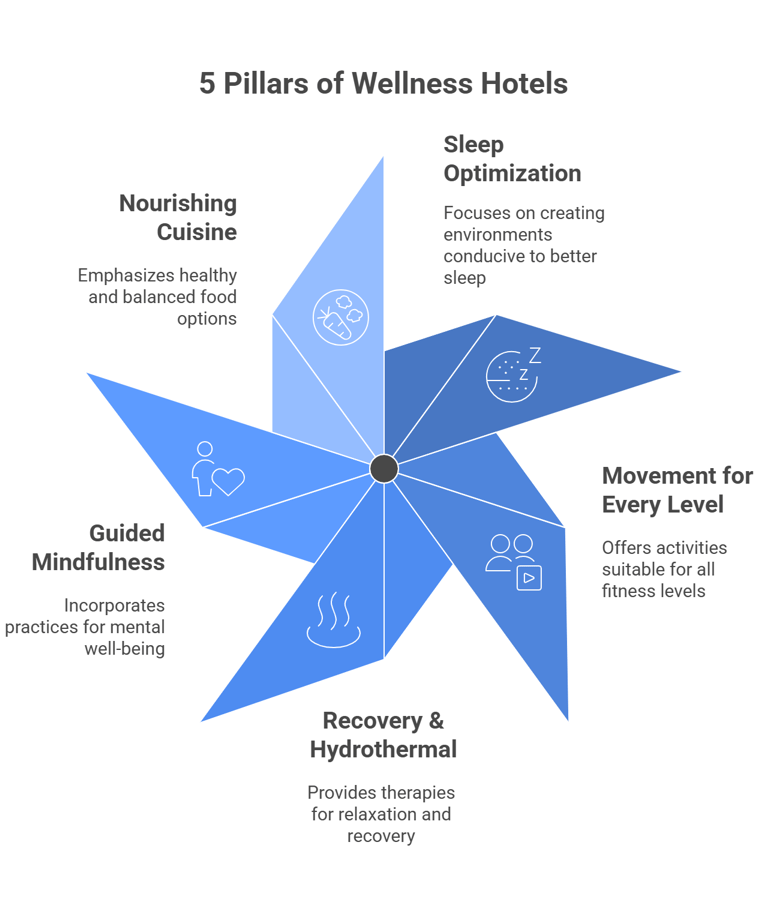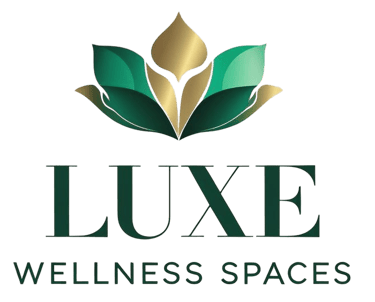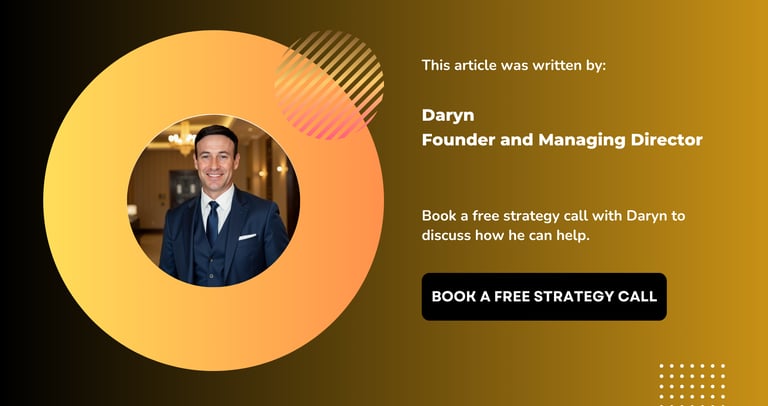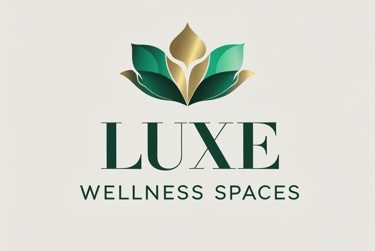Wellness Travel Trends 2025: Must-Have Hotel Wellness
Wellness tourism is now 18% of travel spend. See what guests expect and how hotels can deliver sleep, spa, fitness, and food programs, with Global Wellness Institute data.
Daryn B
9/12/20255 min read


Modern travelers expect hotel wellness to be intentional, not an add-on. Programs that blend great sleep, movement, recovery, mindfulness, and nourishing cuisine now drive bookings, rate, and loyalty. Wellness trips account for a disproportionate share of travel spend, and surveys show most upscale travelers plan health-oriented stays.
Five key facts
Wellness trips represent ~19% of all tourism spend, nearly 1 in 5 travel dollars (Global Wellness Institute, Nov-2023).
Wellness tourism crossed the $1T mark in 2024, and continues to grow (Global Wellness Institute, Nov-2023).
70% of travelers in luxury networks seek relaxation and disconnection through wellness travel (Virtuoso, Aug-2024).
73% of global respondents plan vacations to improve mental, physical, and emotional health; 43% have chosen a hotel for its spa/wellness amenities (American Express Travel, Mar-2023).
Sleep is a headline need: Hilton reports more than a quarter of travelers will book a spa or wellness treatment to enhance sleep (Hilton Trends, Sep-2024).
Travelers are no longer asking if your hotel has a spa or gym. They want to know how your wellness offer helps them sleep better, move daily, eat well, and reset from stress. Do that credibly and you win longer stays, higher daily rates, and repeat guests.
Wellness is now a booking driver, not a bonus. Hotels that perform best deliver five pillars: sleep optimization (quiet rooms, bedding, circadian lighting), movement for every level (strength, mobility, outdoor options), recovery & hydrothermal (sauna, cold, contrast therapy), guided mindfulness (breathwork, meditation), and nourishing cuisine (whole foods, plant-forward, low-alcohol). This aligns with market data showing wellness trips command nearly one-fifth of travel spend, and the majority of upscale travelers actively seek wellness-focused stays.
What’s driving guest expectations:
Short flights, long stress cycles. After years of disruption, travelers want rest, nature, and simple routines that travel well: good sleep, daily movement, lower stimulus, and real food. Luxury audiences also expect personalization: the program adapts to them, not the other way around. Sleep tourism and restorative stays are rising, with guests booking treatments that directly support rest.
Latest wellness offerings guests now look for:
Sleep programs: bedding menus, blue-light management, circadian lighting, nap rituals, and post-flight recovery.
Meditation and breathwork: short guided sessions at wake-up, sunset, or pre-sleep; in-room app access.
Strength + mobility first: smart gyms, outdoor circuits, mobility zones, hiking or beach runs mapped from the lobby.
Recovery: sauna, cold plunge, contrast therapy, compression boots, and guided stretch.
Organic, low-alcohol cuisine: plant-forward menus, mocktails, hydration bars; “dry tripping” continues to trend.
Specialist retreats: short, targeted resets—sleep, gut health, women’s health, and longevity-light.
Mini case study:
A 220-key coastal resort introduced a “Sleep Well, Perform Well” bundle: white-noise option, blackout protocol, magnesium mocktail, 20-minute guided breathwork, and a 45-minute recovery circuit (sauna + cold). Marketing focused on jet-lag relief. In one quarter, Spa capture rose from 8% to 12%; average treatment rate increased 9%; late checkout add-on grew 14%. F&B saw a 17% lift on alcohol-free sales. The bundle cost under $12 per occupied room to operate and added ~$18 in incremental RevPOR.
A balanced, contrary take:
Medicalized “longevity” menus are exploding, but many interventions lack strong evidence, carry regulatory caveats, or can be risky for some guests. Press attention shows interest and concern in equal measure. Hotels should emphasize proven basics (sleep, nutrition, movement, stress care) and partner with licensed clinicians for anything beyond spa scope.
Checklist you can apply today
Map your five pillars: sleep, move, recover, mindfulness, nourish.
Create one signature 24-hour wellness itinerary guests can follow.
Make one offer per profile: business traveler, couple, family, solo reset.
Add a clear pre-arrival opt-in (pillows, meal style, training level).
Train the team to speak in simple, benefit-led language.
Track capture rate, RevPOR, class occupancy, and repeat rate monthly.
Try this in 5 minutes
Put a “Sleep Essentials” card in rooms with three options: eye mask, herbal tea, and white-noise QR.
Add a sunrise stretch (15 minutes) in a quiet space; cap at 8 guests.
Rename the healthiest entrée with a benefit: “Jet-lag Recovery Bowl.”
Common mistakes (and fixes):
Mistake: Buying gear before defining a guest problem.
Fix: Write the guest use case first, then spec the solution.Mistake: Only serving the “already fit.”
Fix: Offer mobility and low-impact options beside heavy strength.Mistake: Calling everything “detox.”
Fix: Describe outcomes plainly—better sleep, less stress, more energy.Mistake: Wellness lives only in the spa.
Fix: Spread touchpoints across rooms, F&B, activities, and digital.Mistake: No measurement.
Fix: Track capture rate, attach rate, and wellness package ADR.
Glossary
Primary vs. secondary wellness traveler: Trip taken for wellness vs. a regular trip with wellness add-ons.
Capture rate: Percent of in-house guests who use your spa or classes.
RevPOR: Revenue per occupied room, including ancillaries.
Contrast therapy: Alternating heat and cold for recovery.
Circadian lighting: Light tuned to support natural sleep-wake cycles.
Attach rate: Percent of stays adding a wellness package or class.
Sleep tourism: Travel designed to improve sleep quality.
Do you require specialist assistance with a new Wellness project, or seeking to improve the operation of your existing space? Book a free strategy call.
FAQ's
Q1: Is wellness travel really big enough to move my hotel’s numbers?
A: Yes. Wellness trips make up close to one-fifth of total travel spend, and guests increasingly choose hotels for wellness value, not only for location. Start with sleep, movement, and nourishing menus to lift capture and RevPOR. Global Wellness Institute
Q2: What are the fastest wins if I have no spa?
A: Focus on sleep (blackout, noise control, cooling bedding), add daily stretch walks, and offer mocktails and whole-food bowls. Package them as a named reset and promote pre-arrival.
Q3: Do I need a “longevity clinic” to stay competitive?
A: No. Evidence-light medical add-ons can add risk and cost. Most travelers want rest, recovery, movement, and nature time, delivered safely and well. Wall Street Journal
Q4: What’s trending in classes and experiences?
A: Short, high-yield formats: breathwork, mobility circuits, guided forest or beach walks, and contrast therapy rotations. Virtuoso and Hilton also highlight sleep-focused stays.
Q5: How should we talk about food?
A: Use plain benefits: energy, gut-friendly, anti-jet lag. Offer plant-forward, low-alcohol choices and hydration as a ritual at check-in.
Q6: What metrics prove wellness ROI?
A: Spa/class capture rate, attach rate to wellness packages, RevPOR, dwell time in outlets, repeat stay rate, and review keywords mentioning sleep, spa, or fitness.
Q7: Do business travelers care about wellness?
A: Yes. “Bleisure” guests expect quick routines that fit calendars: pre-meeting mobility, 20-minute recovery, and sleep-support amenities.
Q8: Which traveler segment is most wellness-motivated?
A: Broadly, luxury and affluent travelers report the strongest interest in relaxation and health-led trips, and many plan vacations around wellness outcomes.
Further reading on our blog: 'Planning and Launching a Successful Wellness Facility.'


• Explore our Spa & Wellness Consultancy to scope project phases and services.
• See how we structure Fitness and Leisure concepts before you commit to equipment.
• Developers and luxury homeowners can review Home Wellness Spaces for private suites and villas.
• Learn why Luxe Wellness Spaces blends design, operations, and growth under one roof.
• View a Concept-to-Launch case study that hit break-even in 90 days.
About The Author
Daryn Berriman is the Founder and Principal Consultant of Luxe Wellness Spaces, a consulting-led studio blending operational expertise and design excellence to create wellness businesses that perform, and spaces that guests love.




